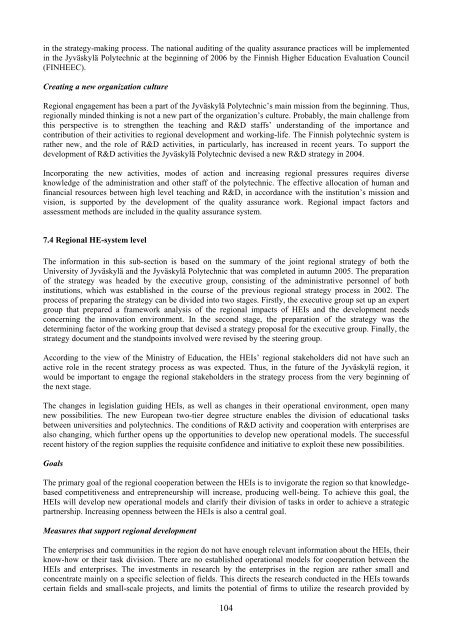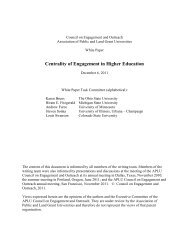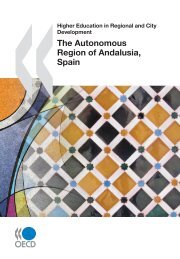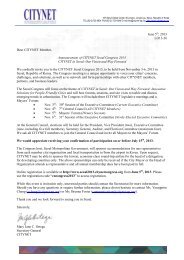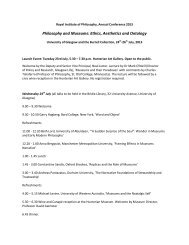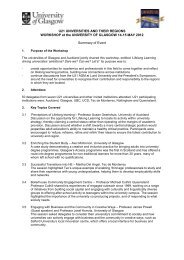The main challenge is to get the University staff to understand that the regional mission is not a separatecomponent but, rather, an integral part of their education and research, and that the higher national andinternational performance profiles serve the regional goals and vice versa.JYVÄSKYLÄ POLYTECHNICInstitutional capacity building for regional involvementA strategic mission of the Jyväskylä Polytechnic is the promotion of well-being, primarily in Central<strong>Finland</strong>, through the advancement of working-life skills, the creation of networks, and throughinternationalization. The strategic choices of the Polytechnic are based on the development needs and goalsof the province and they are always part of the regional innovation strategy. According to the Polytechnic’svision, it will be known as a higher education community specialized in the development of working life andthe generation of new skills, well-being and competitive advantage within its sphere of influence. Its regionaldevelopment tasks include both strengthening the growth centre and supporting the development of theperipheral areas of the province.The institutional structures (including management) at the Jyväskylä Polytechnic are favourable for regionalengagement. The owners of the Jyväskylä Polytechnic Ltd. are: the City of Jyväskylä (55%), the MunicipalFederation of Education in the Jyväskylä District (35%), the Municipal Federation of Vocational Educationin Äänekoski (5%) and the Municipal Federation of Vocational Education in the Jämsä District (5%). Inaddition to the members from the various municipal federations and politicians, the Polytechnic’s boardconsists of members from the business sector. Thus, the organizational and ownership structure allows theinfluence of external bodies in decision making.The communication with regional stakeholders is also frequent, via the joint strategy work and activeparticipation in the regional bodies. The advisory councils in each school comprising members of thebusiness sector and other regional actors are important channels of information exchange in developing theteaching and R&D to meet the regional needs. The new development manager posts that were created to addto the capability to respond to the regional needs, also promote the more coordinated activities and regionalengagement of each school. Besides the development managers, numerous project managers and workers arehired to carry out regional projects.Human and financial resources management<strong>Region</strong>al activities are an integral part of the Jyväskylä Polytechnic’s operations. Thus, the staff are notrewarded separately for regional engagement. The Ministry of Education annually awards performancebasedgrants to certain tasks that highlight impacts on society. The Jyväskylä Polytechnic has beensuccessful in this regard: in two successive years, 2003 and 2004, it was awarded grants for its effectiveR&D sector and, in 2004, also because of its successful performance in degree education. The increasingdependence on external funding and the decreasing resources of the EU’s structural funds elevates theimportance of project activities. In the future, the role of project activities will be increasingly stressed in thework tasks of the staff at the Jyväskylä Polytechnic.In the education of staff, quality assurance and collaboration with the employment sector are particularlyhighlighted. One challenge in this area is the transfer of information and knowledge from the institution tothe employment sector and vice versa. The R&D support unit assists the staff in their projects activities (e.g.in planning, funding issues and coordination of projects) and organizes education.Particularly since autumn 2004, quality assurance work has been a focal point for the Polytechnic’s keyfunctions: in education, R&D and regional effectiveness. Quality assurance at the Jyväskylä Polytechnictakes place at two levels. Firstly, the creation of an effective quality control system is based on thedevelopment of a high quality educational culture. On another level, the actual quality assurance systemconsists of a number of measurement, documentation and analytical tools, with which information isgathered to support the decisions regarding the improvement and development of activities. Thedevelopment of Jyväskylä Polytechnic’s own Balanced Scorecard (BSC) integrates quality assurance tightly103
in the strategy-making process. The national auditing of the quality assurance practices will be implementedin the Jyväskylä Polytechnic at the beginning of 2006 by the Finnish Higher Education <strong>Evaluation</strong> Council(FINHEEC).Creating a new organization culture<strong>Region</strong>al engagement has been a part of the Jyväskylä Polytechnic’s main mission from the beginning. Thus,regionally minded thinking is not a new part of the organization’s culture. Probably, the main challenge fromthis perspective is to strengthen the teaching and R&D staffs’ understanding of the importance andcontribution of their activities to regional development and working-life. The Finnish polytechnic system israther new, and the role of R&D activities, in particularly, has increased in recent years. To support thedevelopment of R&D activities the Jyväskylä Polytechnic devised a new R&D strategy in 2004.Incorporating the new activities, modes of action and increasing regional pressures requires diverseknowledge of the administration and other staff of the polytechnic. The effective allocation of human andfinancial resources between high level teaching and R&D, in accordance with the institution’s mission andvision, is supported by the development of the quality assurance work. <strong>Region</strong>al impact factors andassessment methods are included in the quality assurance system.7.4 <strong>Region</strong>al HE-system levelThe information in this sub-section is based on the summary of the joint regional strategy of both theUniversity of Jyväskylä and the Jyväskylä Polytechnic that was completed in autumn 2005. The preparationof the strategy was headed by the executive group, consisting of the administrative personnel of bothinstitutions, which was established in the course of the previous regional strategy process in 2002. Theprocess of preparing the strategy can be divided into two stages. Firstly, the executive group set up an expertgroup that prepared a framework analysis of the regional impacts of HEIs and the development needsconcerning the innovation environment. In the second stage, the preparation of the strategy was thedetermining factor of the working group that devised a strategy proposal for the executive group. <strong>Final</strong>ly, thestrategy document and the standpoints involved were revised by the steering group.According to the view of the Ministry of Education, the HEIs’ regional stakeholders did not have such anactive role in the recent strategy process as was expected. Thus, in the future of the Jyväskylä region, itwould be important to engage the regional stakeholders in the strategy process from the very beginning ofthe next stage.The changes in legislation guiding HEIs, as well as changes in their operational environment, open manynew possibilities. The new European two-tier degree structure enables the division of educational tasksbetween universities and polytechnics. The conditions of R&D activity and cooperation with enterprises arealso changing, which further opens up the opportunities to develop new operational models. The successfulrecent history of the region supplies the requisite confidence and initiative to exploit these new possibilities.GoalsThe primary goal of the regional cooperation between the HEIs is to invigorate the region so that knowledgebasedcompetitiveness and entrepreneurship will increase, producing well-being. To achieve this goal, theHEIs will develop new operational models and clarify their division of tasks in order to achieve a strategicpartnership. Increasing openness between the HEIs is also a central goal.Measures that support regional developmentThe enterprises and communities in the region do not have enough relevant information about the HEIs, theirknow-how or their task division. There are no established operational models for cooperation between theHEIs and enterprises. The investments in research by the enterprises in the region are rather small andconcentrate mainly on a specific selection of fields. This directs the research conducted in the HEIs towardscertain fields and small-scale projects, and limits the potential of firms to utilize the research provided by104
- Page 1 and 2:
OECD/IMHE ‐ Supporting thecontrib
- Page 3 and 4:
SUMMARYTogether with 13 other regio
- Page 5 and 6:
8.2 Increasing the regional effecti
- Page 7 and 8:
I INTRODUCTION1.1 Strengthening the
- Page 9 and 10:
development. The aim is that region
- Page 11 and 12:
The self-evaluation considered here
- Page 13 and 14:
densely populated cities in Finland
- Page 15 and 16:
1,9 %1,7 %1,5 %1,3 %Population chan
- Page 17 and 18:
The share of jobs in primary produc
- Page 19 and 20:
New pillars of future’s developme
- Page 21 and 22:
Jyväskylä0,60,91,11,0Central Finl
- Page 23 and 24:
2.4 Governance StructureMunicipalit
- Page 25 and 26:
of its development outside the cent
- Page 27 and 28:
III CHARACTERISTICS OF THE HIGHER E
- Page 29 and 30:
continuing education and open unive
- Page 31 and 32:
The Science and Technology Policy C
- Page 33 and 34:
3.2 Regional dimension within the n
- Page 35 and 36:
order to respond to the challenges
- Page 37 and 38:
14001200Master's degreesDoctoratesN
- Page 39 and 40:
900800Youth graduatedAdult graduate
- Page 41 and 42:
provide information for the basis o
- Page 43 and 44:
CabinetParliamentSTPCSteering (andf
- Page 45 and 46:
5,04,0Billion euros3,02,01,00,083 8
- Page 47 and 48:
The number of refereed articles is
- Page 49 and 50:
Centre of expertisePaper industryBi
- Page 51 and 52:
The Institute for Environmental Res
- Page 53 and 54: and systematic gradually progressin
- Page 55 and 56: are seen to be very important chann
- Page 57 and 58: Internal support units of HEIsThe F
- Page 59 and 60: of interviewed HEI staffs, the coop
- Page 61 and 62: areas of the region’s Centre of E
- Page 63 and 64: system of Jyväskylä and the HEIs
- Page 65 and 66: V CONTRIBUTION OF TEACHING AND LEAR
- Page 67 and 68: esources to establish new activitie
- Page 69 and 70: The main problem for the Finnish la
- Page 71 and 72: longer. 2.5% of the Jyväskylä Pol
- Page 73 and 74: activities. As a part of the new qu
- Page 75 and 76: education programmes consisting of
- Page 77 and 78: the TE-Centre of Central Finland an
- Page 79 and 80: practices in the provision of educa
- Page 81 and 82: Reason forskillupgradingDescription
- Page 83 and 84: Strengths+ HEIs are actively confro
- Page 85 and 86: taxation, to lower the unemployment
- Page 87 and 88: Box 6.2 The WIRE -projects: Support
- Page 89 and 90: indoor ice-skating rink, the Rauhal
- Page 91 and 92: The School of Cultural Studies at t
- Page 93 and 94: the number of registered customers
- Page 95 and 96: Box 6.9 Environmental management in
- Page 97 and 98: Strengths+ The significance of HEIs
- Page 99 and 100: eferring to the regional developmen
- Page 101 and 102: Key topics relating to changes in t
- Page 103: participation in the decision makin
- Page 107 and 108: 7.5 Critical points in promoting th
- Page 109 and 110: 7.Cooperation in strategies concern
- Page 111 and 112: egion is according to national and
- Page 113 and 114: oundaries for further developmental
- Page 115 and 116: joining resources and operations by
- Page 117 and 118: Discussion proposal 15: To ensure d
- Page 119 and 120: achieved by the horizontal utilizat
- Page 121 and 122: Appendix 2 Information on data used
- Page 123 and 124: and finding synergy between the oth
- Page 125 and 126: School of BusinessRoleThe School of
- Page 127 and 128: The challenge of the school from re
- Page 129 and 130: developing wellness and environment
- Page 131 and 132: Faculty of EducationRoleThe Faculty
- Page 133 and 134: and/or graduation thesis is a signi
- Page 135 and 136: Areas of strength and prioritising
- Page 137 and 138: Agora Center’s partners from the
- Page 139 and 140: Currently the priority of ITRI’s
- Page 141 and 142: Weak spots and areas to develop in
- Page 143 and 144: Employment and Economic Development
- Page 145 and 146: Appendix 3 Analysis of the most sig
- Page 147 and 148: Appendix 4 Regional effects (input-
- Page 149 and 150: The overall value of production cre
- Page 151 and 152: Appendix 5 Reform of regional struc
- Page 153 and 154: Appendix 7 Provision of education i
- Page 155 and 156:
Appendix 8 Statistical information
- Page 157 and 158:
Appendix 10 Statistics on financing
- Page 159 and 160:
Appendix 12 Labour market activity
- Page 161 and 162:
Appendix 14 Master’s Programmes a
- Page 163 and 164:
Uusiutuvan energian tutkimusohjelma
- Page 165 and 166:
BIBLIOGRAPHYAcademy of Finland (200


